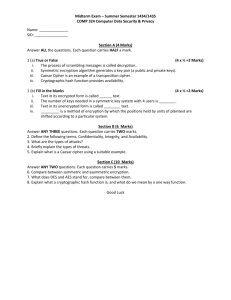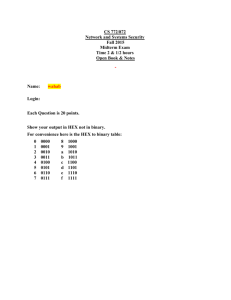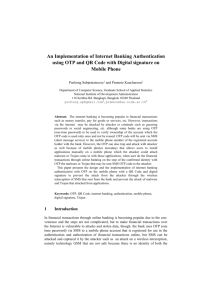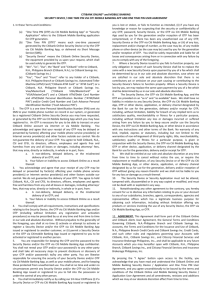1 .introduction - Academic Science,International Journal of
advertisement
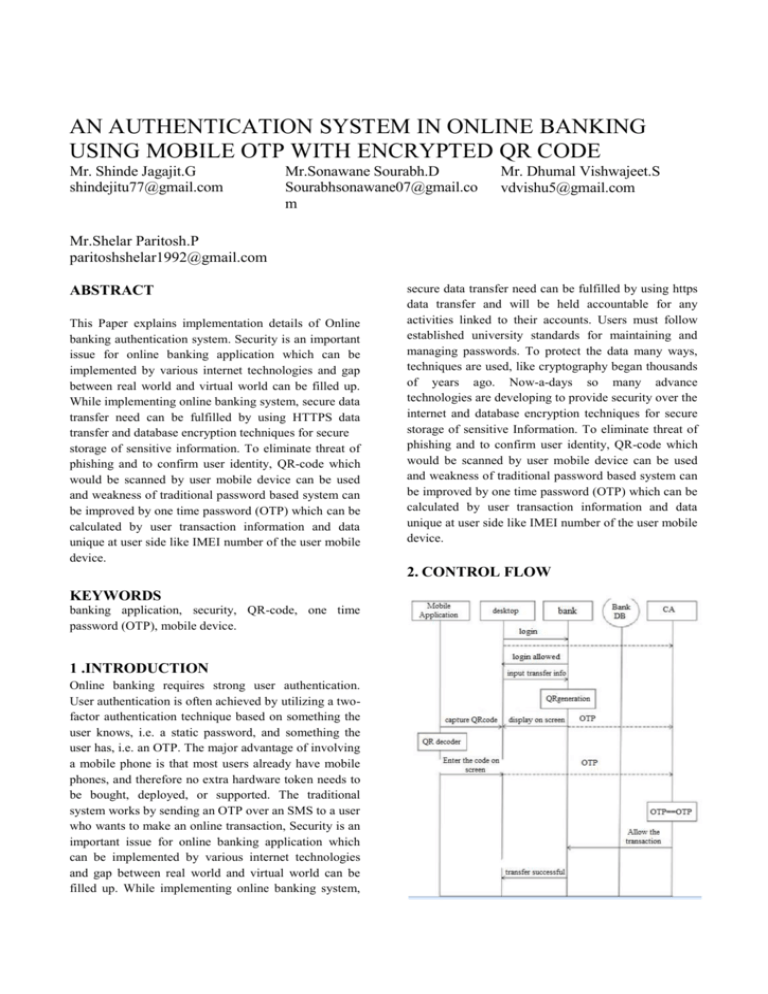
AN AUTHENTICATION SYSTEM IN ONLINE BANKING USING MOBILE OTP WITH ENCRYPTED QR CODE Mr. Shinde Jagajit.G shindejitu77@gmail.com Mr.Sonawane Sourabh.D Sourabhsonawane07@gmail.co m Mr. Dhumal Vishwajeet.S vdvishu5@gmail.com Mr.Shelar Paritosh.P paritoshshelar1992@gmail.com ABSTRACT This Paper explains implementation details of Online banking authentication system. Security is an important issue for online banking application which can be implemented by various internet technologies and gap between real world and virtual world can be filled up. While implementing online banking system, secure data transfer need can be fulfilled by using HTTPS data transfer and database encryption techniques for secure storage of sensitive information. To eliminate threat of phishing and to confirm user identity, QR-code which would be scanned by user mobile device can be used and weakness of traditional password based system can be improved by one time password (OTP) which can be calculated by user transaction information and data unique at user side like IMEI number of the user mobile device. secure data transfer need can be fulfilled by using https data transfer and will be held accountable for any activities linked to their accounts. Users must follow established university standards for maintaining and managing passwords. To protect the data many ways, techniques are used, like cryptography began thousands of years ago. Now-a-days so many advance technologies are developing to provide security over the internet and database encryption techniques for secure storage of sensitive Information. To eliminate threat of phishing and to confirm user identity, QR-code which would be scanned by user mobile device can be used and weakness of traditional password based system can be improved by one time password (OTP) which can be calculated by user transaction information and data unique at user side like IMEI number of the user mobile device. 2. CONTROL FLOW KEYWORDS banking application, security, QR-code, one time password (OTP), mobile device. 1 .INTRODUCTION Online banking requires strong user authentication. User authentication is often achieved by utilizing a twofactor authentication technique based on something the user knows, i.e. a static password, and something the user has, i.e. an OTP. The major advantage of involving a mobile phone is that most users already have mobile phones, and therefore no extra hardware token needs to be bought, deployed, or supported. The traditional system works by sending an OTP over an SMS to a user who wants to make an online transaction, Security is an important issue for online banking application which can be implemented by various internet technologies and gap between real world and virtual world can be filled up. While implementing online banking system, 3. ALGORITHMS TTJSA for Encryption Purpose of the Embedded Data TTJSA [1] is a combined symmetric key cryptographic method, which is formed of generalized modified Vernam cipher, MSA and NJJSA symmetric key cryptographic methods. Brief study of the methods used in TTJSA algorithm is as follows: 1) Modified Vernam Cipher In this step, we break the whole file into different small blocks (like in Block Cipher system []), where each block size should be less than or equal to 256 byes. Then we follow these steps: Step1: Perform normal Vernam Cipher method with the block of randomized key i.e. each byte of blocks of the file + each byte of the blocks of randomized key. Step 2: If the pointer reaches the end of each block then after performing Vernam Cipher method, pass the remainder of the addition of the last byte of the file block with the last byte of the key to the next file block and add the remainder with the first byte of the that file block. Step 3: Perform Step 1 and Step 2 until the whole file isencrypted and repeat this step for random number of times. After performing the aforementioned steps, we again merge the blocks of the encrypted file and thus we get the final encrypted result of this modified Vernam Cipher method. 2) NJJSAA Algorithm The encryption number (=secure) and randomization number (=times) is calculated according to the method mentioned in MSA algorithm [2]. Step 1: Read 32 bytes at a time from the input file. Step 2: Convert 32 bytes into 256 bits and store in some 1-dimensional array. Step 3: Choose the first bit from the bit stream and also the corresponding number(n) from the key matrix. Interchange the 1st bit and the n-th bit of the bit stream. Step 4: Repeat step-3 for 2nd bit, 3rd bit...256-th bit of the bit stream Step 5: Perform right shift by one bit. Step 6: Perform bit(1) XOR bit(2), bit(3) XOR bit(4),...,bit(255) XOR bit(256) Step 7: Repeat Step 5 with 2 bit right, 3 bit right,...,n bit right shift followed by Step 6 after each completion of right bit shift. 3) MSA Encryption and Decryption Algorithm Nath et al. proposed a symmetric key method where they have used a random key generator for generating the initial key and that key is used for encrypting the given source file. MSA method is basically a substitution method where we take 2 characters from any input file and then decryptions. The key matrix (16x16) is formed from all characters (ASCII code 0 to 255) in a random order. The randomization of key matrix is done using the following function calls: Step-1: call Function cycling() Step-2: call Function upshift() Step-3: call Function downshift() Step-4: call Function leftshift() Step-5: call Function rightshift() The idea of these functions is to make elements in a square matrix in a random order so that no one can predict what will be the nearest neighbour of a particular element in that matrix. This method is basically modified Playfair method. In Playfair method one can only encrypt Alphabets but in MSA one can encrypt any character whose ASCII code from 0-255 and one can apply multiple encryption here which is not possible in normal Playfair method. B. Generation of QR Code A QR code is a matrix-typed two-dimensional bar code which indicates information with black and white cross stripes The QR code system, or Quick Response code system, has a quick decoding speed and records data with density higher than the bar code system. A single QR code can record 7,089 numbers, 4,296 letters mixed with numbers and English alphabets, 2,953 binary numbers, or 1,817 characters of Korean or Chinese. Furthermore, approximately 30 percent in maximum can be recovered by the error correction function in case part of the code is damaged or wrongly read. According to the size of data to be recorded, the structure can be expanded in an easy way. Fig: QR CODE To create a QR code , we first create a string of data bits. This string includes the characters of the original message (encrypted message in this case) that you are encoding, as well as some information bits that will tell a QR decoder what type of QR Code it is. After generating the aforementioned string of bits, we use it to generate the error correction code words for the QR Code. QR Codes use Reed-Solomon Error Correction technique Please note that in coding theory, Reed-Solomon codes (RS codes) are non-binary cyclic error correction codes invented by Irving S. Reed and Gustave Solomon. After the generation of bit-string and error correction code words, the resultant data is used to generate eight different QR Codes, each of which uses a different mask pattern. A mask pattern controls and changes the pixels to light or dark ones, according to a particular formula. The eight mask pattern formulas are defined in the QR Code specification, which is referred at the time of mask generation needed for the QR Code generation. Each of the eight QR codes is then given a penalty score that is based on rules defined in the QR specification. The purpose of this step is to make sure that the QR code doesn't contain patterns that might be difficult for a QR decoder to read, like large blocks of same-colored pixels, for example. After determining the best mask pattern, the QR Code, which uses the best mask pattern, is generated and shown as an output. If the size of the encrypted message becomes more than 1,264 characters then the characters appearing after 1,264 characters are used separately to generate another QR Code and the above mentioned process is repeated until and unless the total encrypted message is converted to QR Code(s). in their mobile phone. Finally, terminate the transfer by user typing of generated OTP code on the screen. References . Symmetric Key Cryptography using Random Key generator: AsokeNath, SaimaGhosh, MeheboobAlamMallik: “Proceedings of International conference on security and management(SAM’10” heldat Las Vegas, USA Jull 12-15, 2010), P-Vol-2, 239244(2010). 3. New Symmetric key Cryptographic algorithm using combined bitmanipulation and MSA encryption algorithm: NJJSAA symmetrickeyalgorithm: NeerajKhanna,JoelJames,JoyshreeNath, SayantanChakraborty, AmlanChakrabarti and AsokeNath : Proceedings ofIEEE CSNT-2011 held at SMVDU(Jammu) 03-06 June 2011, Page125-130(2011 Conclusion Now-a-days, uses of online banking application are increased. Security is an important issue for handling such services. Current system provide security card based facility to authenticate user but this is not much more secure and will not be available for any time or situation. To overcome such type of issues we propose online banking authentication system using QR-code and OTP. The bank generates the QR-code using user input transfer information and then user need to recognize as to read the code using their mobile phone, after generate the OTP code using transfer information and the hashed users mobile device number Confidential Encrypted Data Hiding and Retrieval Using QR Authentication System 2013 IEEE. "QR Code, Wikipedia", http://en.wikipedia.org/wiki/QR_code. Symmetric Key Cryptography using Random Key generator: “Proceedings of International conference on security and management (SAM’10” held at Las Vegas, USA Jull 12-15, 2010), P-Vol-2, 239-244(2010). Symmetric key cryptosystem using combined cryptographic algorithms - Generalized modified Vernam Cipher method, MSA method and NJJSAA method: TTJSA algorithm “ Proceedings of Information and Communication Technologies (WICT), 2011 “ held at Mumbai, 11th – 14th Dec, 2011, Pages:1175-1180. 1. Symmetric key cryptosystem using combined cryptographicalgorithms Generalized modified Vernam Cipher method, MSAmethod and NJJSAA method: TTJSA algorithm “ Proceedings ofInformation and Communication Technologies (WICT), 2011 “ heldat Mumbai, 11th – 14th Dec, 2011, Pages:1175-1180.






